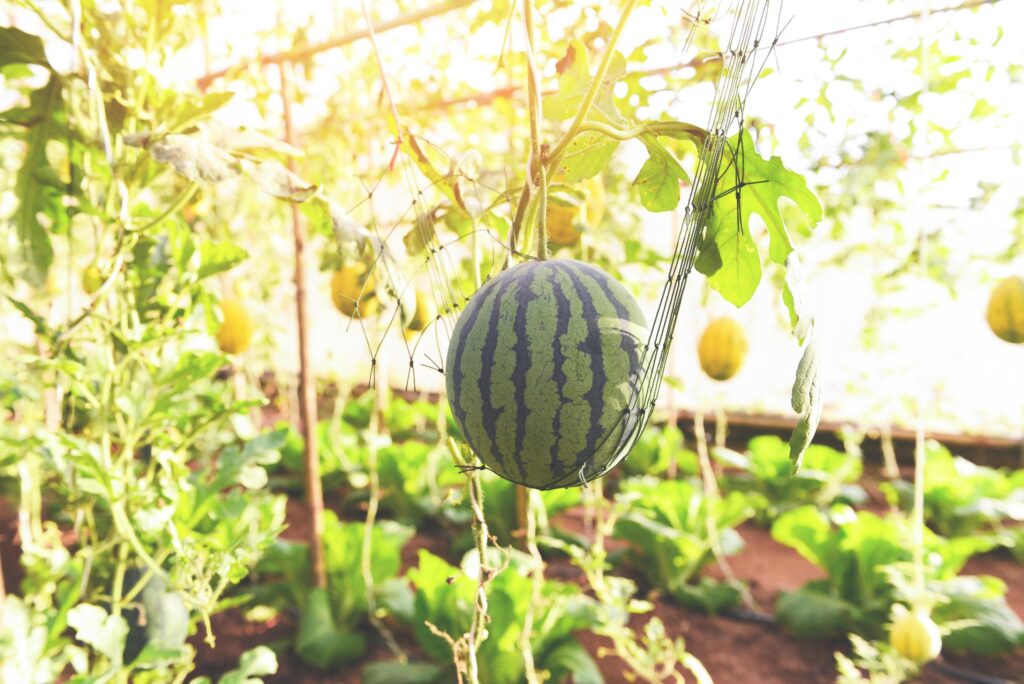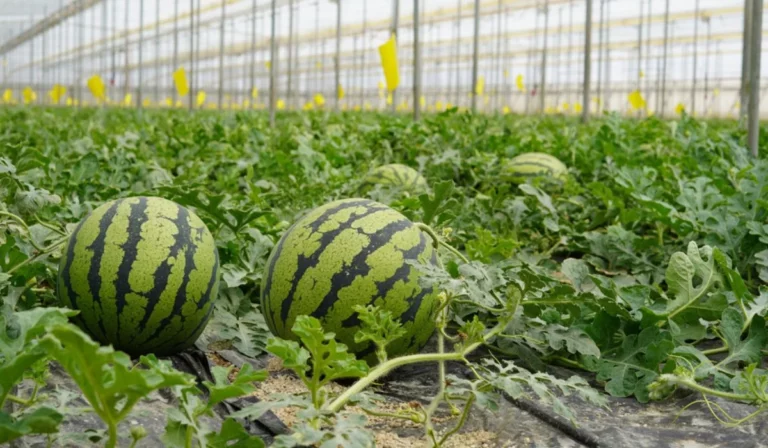Growing watermelons in a greenhouse is a great idea for yummy, homegrown treats. Greenhouses help by giving the right conditions and making the growing season longer. To get started, pick a good greenhouse and make sure it’s warm, not too wet, and gets enough sunlight. Choose watermelon types that like greenhouses and fit your taste and size preferences. Keep the soil good, water the plants well, and watch out for bugs. Help with pollination, take care of the greenhouse, and harvest the watermelons when they’re ready.
Why Choose a Greenhouse for Watermelon?
Choosing a greenhouse for watermelon cultivation offers several advantages, although it’s important to note that watermelons are traditionally grown outdoors. However, in certain climates or for specific purposes, using a greenhouse can be beneficial. Here are some reasons why you might choose a greenhouse for watermelon cultivation
Extended Growing Season
Greenhouses create a controlled environment, allowing you to extend the growing season. This is particularly useful for watermelons, which thrive in warm temperatures. A greenhouse provides warmth and protection against frost, allowing you to start growing watermelons earlier in the spring and continue later into the fall.
Climate Control

Greenhouses provide the ability to control temperature, humidity, and light levels. This is advantageous for watermelons, as they prefer warm and consistent conditions. By maintaining optimal growing conditions, you can potentially increase yield and improve fruit quality.
Protection from Pests and Diseases
Greenhouses offer a physical barrier against pests and diseases, reducing the risk of infestations. Watermelons can be susceptible to certain pests and diseases, and a greenhouse can help create a more isolated and controlled environment, limiting exposure.
Optimized Watering
Greenhouses allow for precise control over irrigation. Watermelon plants require consistent and adequate moisture, and a greenhouse allows you to regulate watering more effectively, reducing the risk of overwatering or underwatering.
Better Pollination Control
Some greenhouse setups enable better control over pollination, which is crucial for watermelon development. You can manually pollinate plants or introduce pollinators in a controlled manner, ensuring efficient fruit set.
Space Utilization
Greenhouses provide vertical space, allowing you to maximize the use of available area. This is beneficial for watermelon vines, which can spread out extensively. Vertical gardening or trellising systems in a greenhouse can help manage space efficiently.
Quality and Consistency
The controlled environment of a greenhouse can contribute to more consistent fruit quality. Factors such as temperature, light, and water can be carefully managed to ensure optimal conditions for watermelon growth, resulting in more uniform and higher-quality fruit.
Experimentation and Research
Greenhouses provide a controlled setting for experimentation and research. If you are a commercial grower or a researcher, a greenhouse allows you to manipulate various environmental factors to study their impact on watermelon growth and development.
What are the Essential Steps for Setting Up Your Greenhouse to Grow Watermelons?
To set up your greenhouse for growing watermelons, start by ensuring good sunlight exposure and proper ventilation. Then, choose well-draining soil, plant watermelon seeds or seedlings, and regulate temperature and humidity inside the greenhouse for proper growth.
Greenhouse Selection and Setup
Size and Structure
Choose the Right Size: Select a greenhouse size that suits the available space and the quantity of watermelons you intend to grow. Consider future expansion if needed.
Durable Construction: Go for a sturdy greenhouse structure capable of withstanding environmental elements and providing long-term durability.
Location
Place the greenhouse in an area with maximum sunlight exposure. Ensure that it receives at least 6-8 hours of direct sunlight daily for optimal photosynthesis and fruit development.
Temperature Control
Heating Systems: Depending on your climate, install heating systems to maintain adequate temperatures during cooler periods. This is crucial, especially for early-season cultivation.
Ventilation: Implement proper ventilation systems to prevent overheating during warmer periods. Adjustable vents and fans can help regulate temperature.
Humidity Management
Install humidifiers to increase humidity in dry climates and dehumidifiers to reduce excess moisture in humid conditions. Maintaining the right humidity levels helps prevent diseases and ensures healthy plant growth.
Temperature, Humidity, and Light Requirements
Temperature Requirements
Day and Night Temperatures: Watermelons thrive in warm temperatures. Aim for daytime temperatures between 80-90°F (27-32°C) and slightly cooler temperatures at night.
Temperature Fluctuations: Minimize temperature fluctuations within the greenhouse to avoid stress on the plants. Consistency is key for optimal growth.
Humidity Requirements
Ideal Humidity Levels: Watermelon plants prefer humidity levels between 60-70%. Consistent humidity promotes healthy flowering and fruit set.
Humidity Monitoring: Use hygrometers to monitor humidity levels regularly. Adjust humidification or dehumidification systems accordingly.
Light Requirements
Natural Sunlight: Greenhouses are designed to capture natural sunlight. Ensure that the greenhouse is oriented to receive sunlight throughout the day.
Supplemental Lighting: In regions with limited sunlight or during winter months, consider supplemental lighting using artificial grow lights to ensure consistent light exposure.
Shading
Install shade cloth to protect watermelon plants from excessive sunlight, especially during peak summer months. This helps prevent heat stress and sunburn.
Light and Dark Cycles
Watermelon plants, like many crops, benefit from consistent light and dark cycles. Use timers for artificial lights to simulate natural day and night conditions.
Which Watermelon Varieties Are Ideal for Successful Greenhouse Growing?
| Watermelon Variety | Characteristics | Taste | Yield |
| Sugar Baby | Compact size | Exceptionally sweet | Personal-sized fruits |
| Mini Love | Compact and bushy | Deep red, sweet, juicy | Small to medium-sized |
| Faerie | Compact vines | Sweet and refreshing | Smaller, round fruits |
| Sweet Beauty | Well-suited for greenhouses | Excellent sweetness | Medium-sized fruits |
| Blacktail Mountain | Compact vines | Rich, sweet flavor | Medium-sized fruits |
| Moon and Stars | Compact varieties | Distinctive sweetness | Medium-sized, unique |
| Sweetheart | Bushy and compact | Sweet and crisp | Small to medium-sized |
What’s the Best Soil for Greenhouse Watermelon?

The best soil for growing watermelons in a greenhouse is loose and well-draining loamy soil. It should have a mix of sand, silt, and clay, allowing for good drainage, retaining important nutrients, and promoting healthy root development for the watermelon plants.
Loamy Texture: Loamy soil combines the best qualities of sand, silt, and clay. It allows for proper drainage while retaining essential nutrients and moisture.
Well-Aerated Structure: The soil should be loose and well-aerated to promote healthy root development. Compacted soil can hinder watermelon growth and drainage.
Rich in Organic Matter: Enhance soil fertility by incorporating organic matter, such as compost or well-rotted manure. Organic matter improves water retention and nutrient availability for the watermelon plants.
pH Range: Aim for a slightly acidic to neutral pH range of 6.0 to 7.0. Regular soil testing is advisable to monitor and adjust pH levels as needed for optimal watermelon cultivation.
Mulching: Applying organic mulch around watermelon plants is beneficial. Mulch helps conserve moisture, suppress weeds, and maintain an even soil temperature. It also prevents soil compaction.
FAQ
What environment is best for watermelon?
Watermelons are best in warm environments with plenty of sunlight. They require well-draining soil, temperatures between 70-90°F (21-32°C), and a frost-free period for optimal growth.
Are watermelons environmentally friendly?
Yes, watermelons are considered environmentally friendly. They are a sustainable fruit, requiring minimal processing and packaging, and the plant’s vines help prevent soil erosion.
What is the best watermelon for cool climate?
The “Sugar Baby” watermelon is a suitable choice for cooler climates. Its smaller size allows it to mature within shorter growing seasons.
Is watermelon good for high temperature?
Yes, watermelons thrive in high temperatures. The heat encourages fruit development, and watermelon plants are well-adapted to warm conditions.
Is watermelon good for hot weather?
Yes, it is. Watermelon is an excellent choice for hot weather. Its high water content helps keep you hydrated, and it’s a refreshing and nutritious treat in hot climates.
What fruit is best in hot weather?
Watermelon is one of the best fruits for hot weather. Its hydrating properties, sweetness, and cooling effect make it a perfect choice during warm days.
Why is watermelon cooling?
Watermelon is cooling due to its high water content (about 92%). This, along with its refreshing taste, makes it a cooling and hydrating fruit, perfect for hot weather.
Is watermelon cool or warm season?
Watermelon is a warm-season crop. It requires warm temperatures for germination and vigorous growth, making it well-suited for summer cultivation.
Final words
To finish it up, growing watermelons in a greenhouse is a great way to have sweet and plentiful fruits for a longer time. By using the right soil, taking good care of your plants, and keeping pests away, you can enjoy the fun of growing your own tasty watermelons.
Your greenhouse becomes a special place where your watermelon plants can thrive, giving you a rewarding and enjoyable gardening experience. Happy gardening!

